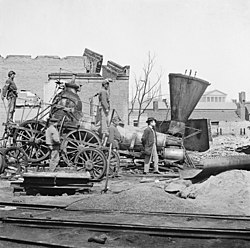Richmond & Petersburg Railroad

Richmond & Petersburg locomotive destroyed in the fall of Richmond, April 1865
|
|
| Locale | Richmond, Virginia |
|---|---|
| Dates of operation | 1838–1898 |
| Successor | Atlantic Coast Line Railroad |
| Track gauge | 4 ft 8 1⁄2 in (1,435 mm) standard gauge |
| Previous gauge | previous gauges: 5 ft (1,524 mm) and 4 ft 9 in (1,448 mm) |
The Richmond and Petersburg Railroad moved passengers and goods between Richmond and Petersburg from 1838 to 1898. It survived the American Civil War and eventually merged into the Atlantic Coast Line Railroad in 1900.
The Richmond and Petersburg was founded in 1836 and sold in 1898. It survived a war and several financial panics. It went from a railroad that only connected trains from Richmond to Petersburg, to a part of an entire east coast system. It went from a slave economy to having fully paid employees.
The Virginia General Assembly granted a charter of a railroad between Richmond and Petersburg in 1836 which connected other railroad lines to make profits transporting cotton and coal to market. The rail was completed to Manchester,Virginia's industry on the south bank of the James River across from Richmond, Virginia. The steam engines would pass right under the terminus of the mule and gravity powered Chesterfield Railroad, which brought coal from Midlothian, Virginia to Manchester. The Richmond and Petersburg Railroad bridge across the river, connecting to Richmond, would be built after the rail line was completed. The Panic of 1837 lead to a reduction in the purchase of subscriptions to ship on the rails so it was difficult to pay for construction. The Virginia Board of Public Works advanced money for their subscription and England loaned money to keep the Richmond and Petersburg Railroad company solvent. The labor for the railroad was provided by slaves, but slave holders collected fees from leasing arrangements, and the railroad company provided clothes for the slaves. The Rail line was completed in 1838.
A branch line was created to to Port Walthall which connected to Washington, Baltimore, Philadelphia and New York City by Steamboat in 1845. In 1846 passengers began to travel this way and freight could be shipped as well. The rail line also carried mail under contract with the U.S. Postal Service
...
Wikipedia
